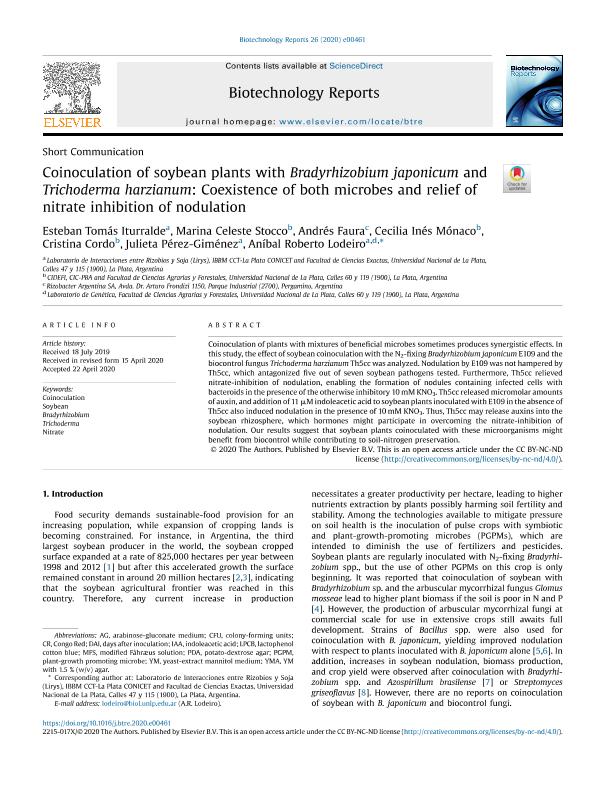Artículo
Coinoculation of soybean plants with Bradyrhizobium japonicum and Trichoderma harzianum: Coexistence of both microbes and relief of nitrate inhibition of nodulation
Iturralde, Esteban Tomás ; Stocco, Marina Celeste
; Stocco, Marina Celeste ; Faura, Andrés; Monaco, Cecilia Ines; Cordo, Cristina; Pérez Giménez, Julieta
; Faura, Andrés; Monaco, Cecilia Ines; Cordo, Cristina; Pérez Giménez, Julieta ; Lodeiro, Anibal
; Lodeiro, Anibal
 ; Stocco, Marina Celeste
; Stocco, Marina Celeste ; Faura, Andrés; Monaco, Cecilia Ines; Cordo, Cristina; Pérez Giménez, Julieta
; Faura, Andrés; Monaco, Cecilia Ines; Cordo, Cristina; Pérez Giménez, Julieta ; Lodeiro, Anibal
; Lodeiro, Anibal
Fecha de publicación:
06/2020
Editorial:
Elsevier
Revista:
Biotechnology Reports
ISSN:
2215-017X
Idioma:
Inglés
Tipo de recurso:
Artículo publicado
Clasificación temática:
Resumen
Coinoculation of plants with mixtures of beneficial microbes sometimes produces synergistic effects. In this study, the effect of soybean coinoculation with the N2-fixing Bradyrhizobium japonicum E109 and the biocontrol fungus Trichoderma harzianum Th5cc was analyzed. Nodulation by E109 was not hampered by Th5cc, which antagonized five out of seven soybean pathogens tested. Furthermore, Th5cc relieved nitrate-inhibition of nodulation, enabling the formation of nodules containing infected cells with bacteroids in the presence of the otherwise inhibitory 10 mM KNO3. Th5cc released micromolar amounts of auxin, and addition of 11 mM indoleacetic acid to soybean plants inoculated with E109 in the absence of Th5cc also induced nodulation in the presence of 10 mM KNO3. Thus, Th5cc may release auxins into the soybean rhizosphere, which hormones might participate in overcoming the nitrate-inhibition of nodulation. Our results suggest that soybean plants coinoculated with these microorganisms might benefit from biocontrol while contributing to soil-nitrogen preservation.
Palabras clave:
COINOCULATION
,
SOYBEAN
,
BRADYRHIZOBIUM
,
TRICHODERMA
,
NITRATE
Archivos asociados
Licencia
Identificadores
Colecciones
Articulos(IBBM)
Articulos de INST.DE BIOTECNOLOGIA Y BIOLOGIA MOLECULAR
Articulos de INST.DE BIOTECNOLOGIA Y BIOLOGIA MOLECULAR
Citación
Iturralde, Esteban Tomás; Stocco, Marina Celeste; Faura, Andrés; Monaco, Cecilia Ines; Cordo, Cristina; et al.; Coinoculation of soybean plants with Bradyrhizobium japonicum and Trichoderma harzianum: Coexistence of both microbes and relief of nitrate inhibition of nodulation; Elsevier; Biotechnology Reports; 26; 6-2020; 1-6
Compartir
Altmétricas



